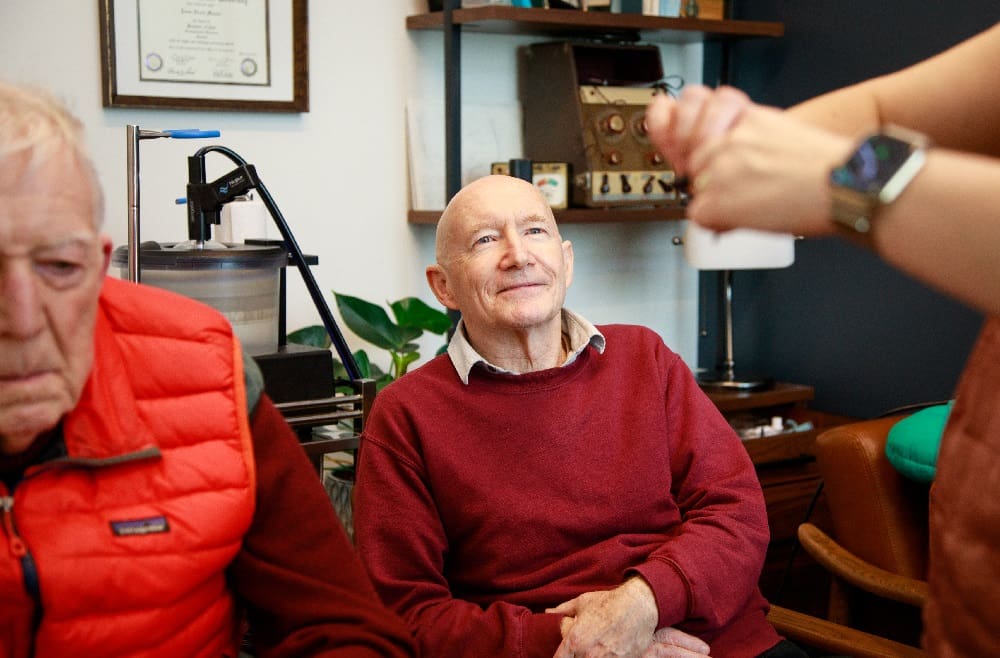2024-06-13
John Chakan, Co-Owner/Practice Manager
Here at Berkeley Hearing Center, we understand the importance of empowering our patients by educating them, their loved ones, other healthcare professionals, and the public about Audiology & hearing health care.
We believe that the ‘informed choice’ is always the best choice. Today we’re going to tackle some of the more common questions our patients experience regarding the physical experience of wearing hearing aids.
Over the years, one of the most consistent issues manufacturers have worked to improve the physical aspects of wearing hearing aids. From our experience, putting on hearing aids for the first time can be a magical experience.
You’re suddenly able to hear, or hear more clearly, so many of those important and/or beautiful sounds that you've been missing out on - grandchildren laughing, birds singing, your colleague’s question.
You’re able to more easily communicate and connect with friends, family, and/or colleagues in more profound and impactful ways. Music has greater detail and ‘body.’
But sometimes, that moment of ‘awe’ is followed by moments of “ow.” From strange sound quality to itchy or sore ears, new hearing aids aren't always immediately a comfortable, enjoyable experience.
But if you give your ears, body, and brain some time to adjust, your patience is well rewarded. To be clear, when properly fit, hearing aids are comfortable in how they feel & sound, easy to use, and effective.
Why Aren’t My New Hearing Aids Comfortable?
Do you remember the first time you wore glasses or contacts? Were they perfectly comfortable from the start? Or have you ever gotten a crown for a tooth? Did they have to remake it?
Heck, think about your favorite pair of jeans or shoes. Did it take time for you to ‘break them in’?
Chances are, it took some time to adjust before they felt ‘right.’ Unsurprisingly, hearing aids work much the same way. But with hearing aids, there are a few different aspects that new users need to adjust to.
Users need to acclimate to both how they sound, as well as how they feel, particularly because they’re worn in a part of the body that is very sensitive (highly innervated) and typically ‘unspoiled,’ as it were.
In contrast, the thin tissue structure, hairs, nerve endings in the external auditory canal (ear canal) acclimate to something new in its environment.
Over 28 million adults could benefit from hearing aids, yet only a few million invest in them. For most people, hearing aid purchases come only after people have already experienced a decent amount of hearing loss for a decent amount of time.
From childhood, the brain learns to filter out extraneous information unconsciously. A healthy auditory system can hear remarkably well in noise, even when competing noise is equally as loud as what we’re trying to hear.
One of the only ‘fringe benefits’ of hearing loss is that sufferers experience a ‘quiet, peaceful world.’ But as we know, the world around us is NOT quiet or (unfortunately) peaceful.
The environmental noises that you've missed over the years suddenly become audible, all at once. So for new hearing aid users, the brain must essentially be re-trained how to hear and use the information it is now receiving.
And the brain has evolved to pay special attention to things that are (suddenly) new to our environment. When we were apes in the trees, if there was a sound, we needed to quickly determine whether it was made by predator, prey, fire, etc.
So instinctually, our nervous system reacts to all of this information with a heightened state of alert. But given time and experience, our brain re-acclimates and begins to filter out those extraneous sounds again unconsciously.
Concurrently, the physical structures of the pinna (outer ear) need time to get used to having a device sitting astride it (along with glasses and mask straps).
In contrast, the thin tissue structure, hairs, nerve endings in the external auditory canal (ear canal) acclimate to something new in its environment.
What Are The Common Issues?
Some of the most common issues we typically address in our clinic include:
Feedback is an issue for any amplification system. If you’ve been in an auditorium and the speakers suddenly produce an ear-splitting shriek, that’s feedback.
The high-pitched whistling sound a hearing aid makes has the same cause-sound that the microphone has picked up, amplified by the system, loud enough to be picked up by the microphone re-amplified again & again.
Though the potential for feedback is normal for any amplification system, it should never happen spontaneously in hearing aids. When it does, it’s often due to waxy buildup in the ear.
But it can also be a sign of a poorly fit hearing aid or one that is being asked to do more than it is capable of. As with all hearing aid issues/problems, it’s a good idea to contact your Audiologist to talk about this issue since a hearing aid feeding back is not helping the user.
Since hearing loss happens gradually, most people don’t notice background noises slowly disappearing.
When you’re fit with a hearing aid, the world of sound comes back all back at once. It takes some time for the brain to adjust. Of course, this may be related to the programmed settings, requiring adjustment/fine-tuning.
The goal for our patients is to have the hearing aids restore as much of a natural hearing experience as possible. But if patients hear too much background noise, such that it interferes with speech understanding, adjustments can be made to minimize the effects.
Also, assistive devices can be employed to improve understanding in the presence of background noise dramatically.
This is, by far, the most common observation we get. Hearing aids will initially affect how the user perceives their own voice, more so even than how they perceive external sounds. How we hear our own voice is integral to each of us.
That’s why it’s so weird to hear your own voice recorded because that’s not how we hear ourselves. So anything that changes how we hear ourselves will be strange.
By definition, we change the user’s perception of sound by giving them back sound they can’t hear. So just by virtue of the appropriate amplification, the user’s voice will sound strange to them.
Typically, this manifests as sounding “tinny,” “like talking in a microphone,” “metallic.” This is the subjective perception of high-frequency sound, which is the most important area we amplify.
In addition, in-the-ear hearing aids (or behind-the-ear models with a custom earmold) can cause an issue referred to as “occlusion.” It’s the same thing that happens when you have a cold, or you plug your ears, and your voice resonates in your head.
Sounds that we generate internally (chewing noises, speech, even breathing) that typically roll out of the ear, get trapped, and resonate in the head.
Some level of occlusion may be perfectly normal, depending on the style of hearing aid or how it’s fit, and which the brain can acclimate to. Improper amplification settings can also cause occlusion issues.
Talk with your Audiologist about what you are experiencing. Based on the information/details provided, the proper cause can be identified and addressed.
Hearing aids are being worn in a sensitive part of the body. But when properly fit, hearing aids should be very comfortable, to the point that most users don’t typically don’t even know they’re wearing them. Most physical fit issues are minor.
The most common one we hear is itchiness. It is typically temporary with the ear adjusting pretty quickly and is seen particularly with fittings where we don’t use a custom earmold.
A slightly more pressing issue we come across (pun intended) is with custom aspects of a fitting, be it with an in-the-ear device or a custom earmold for a behind-the-ear model.
These custom products are based on ear impressions taken from the patient’s own ears and should fit like puzzle pieces. But like with any prosthetic, the aid or mold may not fit ‘right’ from the get-go.
A poorly fitting mold isn’t necessarily an indication that it was made incorrectly. The impression of the ear(s) we take is a static impression of a very dynamic system.
So with jaw movement, sometimes the aid or mold presses or rubs an area it isn’t intended to. Or if the user doesn’t properly insert it, it may also press a part of the ear, causing a sore.
When it comes to the physical fit, though, any initial discomfort should quickly improve. If it does not, contact your provider immediately as it won’t improve without their intervention.
As with the amplification’s subjective perception, your ears may need some time to adjust to the physical side of wearing a hearing aid. But as with just about all issues associated with hearing aids, if the Audiologist knows about the problem, they should be able to address it.
Adjusting for a Better Fit:
If the discomfort persists despite a period of adjustment, you might need to consider an alternative approach. Sometimes, switching to a custom earmold designed to fit your unique ear shape can significantly reduce irritation and improve comfort. Additionally, adjusting the material used for the earmold or the dome (the soft tip that sits in the ear canal) can make a big difference.
Some materials are hypoallergenic and better suited for sensitive skin, so discussing material options with your hearing care provider is essential if you're experiencing skin reactions or soreness. Remember, there’s no one-size-fits-all solution – it’s about finding the best combination that works for you.
Exploring Different Hearing Aid Styles:
If you continue to experience discomfort with your current hearing aids, it may be worth considering a different style or model. Hearing aids come in various styles, such as behind-the-ear (BTE), in-the-ear (ITE), and receiver-in-canal (RIC) models. Each style fits differently in the ear and can provide varying levels of comfort and performance.
For example, some individuals find that a smaller in-the-canal (ITC) hearing aid feels more natural, while others may prefer the more robust fit of a BTE model. Discussing these options with your audiologist can help determine which style suits your ear shape, hearing needs, and comfort preferences best. A simple change in the style or fit could alleviate prolonged discomfort and provide a better overall experience.
Expect An Adjustment Period
It’s important to understand that with wearing hearing aids, there’s an adjustment period. It’s different for everyone. Some people adjust within days, and others may take more time to adjust to these new devices in their ears fully.
When properly fit, hearing aids should be very comfortable in how they feel and sound. Anything that keeps you from wanting to wear them needs to be brought to the attention of your Audiologist.
Do you need help with your new hearing aids? Contact us and set up an appointment. We can help you get past those early blues and fitting issues.
John Chakan, Co-Owner/Practice Manager






